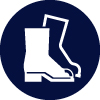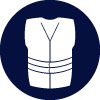
Vegetation Miscellaneous 20 02 01
The quality, usability and the ease of removal will determine how vegetation is removed, reused, recovered, recycled or sent for disposal. Reasonably sized trees , bushes and lawns in good condition and not contaminated will have a reuse value, especially if there is a large number of healthy specimens. They should be extracted, prepared and stored safely on-site with specific requirements to maintain their health until translocated into the landscape of the new design. They should also be stored away from plant movements to prevent damage. Vegetation destined for composting, chipping or recycling either on- or off-site should be segregated from other materials to prevent contamination. Vegetation destined for energy recovery or disposal can be stored in skips.
Usage & Probable Locations
Vegetation will often be used for landscaping, screening, soil stabilisation, surface cover and fruit bearing purposes. It is located within projects and around buildings and highways to provide green space, functional landscaping, perimeter security and to create gardens, tree avenues and woodlands. Some vegetation will be planned, others will be invasive especially on brownfield sites and alongside water.
Personal Protective Equipment
PPE requirements indicated are for guidance purposes only. DRIDS has identified the PPE that is mandatory on all demolition projects and ones that may be required subject to site specific Risk Assessment & Method Statement (RAMS). Hover over the icon to determine the types of PPE required for the removal of this material.
Removal, Segregation & Storage
The quality, usability and the ease of removal will determine how vegetation is removed, reused, recovered, recycled or sent for disposal. Reasonably sized trees , bushes and lawns in good condition and not contaminated will have a reuse value, especially if there is a large number of healthy specimens. They should be extracted, prepared and stored safely on-site with specific requirements to maintain their health until translocated into the landscape of the new design. They should also be stored away from plant movements to prevent damage. Vegetation destined for composting, chipping or recycling either on- or off-site should be segregated from other materials to prevent contamination. Vegetation destined for energy recovery or disposal can be stored in skips.
Tools
Fixtures, Fittings & Connections
Vegetation has been traditionally grown or laid on soils, clays and blinding sands with a range of drainage media including gravels, sands, crushed stone and crushed inert materials. Some vegetation is planted in soil beds, within landscape structures, along tree lines or alongside water features such as rivers, streams, brooks and ponds. Some vegetation naturally generates, including invasive species. Fixings and connections are rarely used, other than stakes and anti-mammal plastic guards, as well as tie wraps or string to secure the trunk to the stake. Some plantations may also incorporate protective fencing.
Health & Safety
Subject to task-specific Risk Assessment & Method Statement (RAMS). Always use correct protective equipment. Wear anti-cut gloves for handling vegetation with snapped branches, thorns or seeping oils to prevent irritation, cuts and splinters. Wear eye protection at all times. Use gloves and eye protection when using a reciprocating saw. Only use harness protection at height as a last resort. Only use 360 plant and attachments if properly trained. Wood chippers should only be used by trained personnel










